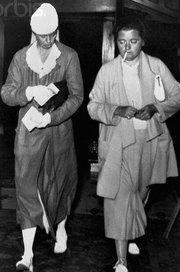Dr. Blassy-Ford High School Drama
 Friday, September 28, 2018 at 5:03PM
Friday, September 28, 2018 at 5:03PM Bombshell: Kavanaugh Accuser’s Salacious High School Yearbooks Scrubbed
Paul Joseph Watson | Infowars.com - September 20, 2018
Christine Blasey Ford’s yearbooks describe wild sex parties, blackouts, erotic male dancers
Christine Blasey Ford’s high school yearbooks, which are filled with references to drunken promiscuous parties where the attendees were not able to remember what happened, have been scrubbed from the Internet.
The Cult of the First Amendment blog was able to save copies of the yearbooks before they disappeared.
Christine Blasey Ford claims that Judge Brett Kavanaugh “physically and sexually assaulted” her during a party in the early 80’s when she was 15 and Kavanaugh was 17, although two other people Ford claims were present when the assault happened have denied that it ever happened.
Ford’s yearbooks, which cover her sophomore, junior and senior years, the exact time frame when she claims the assault happened, portray a debauched environment of constant binge drinking and partying.


“Lastly one cannot fail to mention the climax of the junior social scene, the party,” reads one passage. “Striving to extend our educational experience beyond the confines of the classroom, we played such intellectually stimulating games as Quarters, Mexican Dice and everyone’s favorite, Pass-Out, which usually resulted from the aforementioned two.”
Another passage emphasizes how “loss of consciousness” at such parties meant that attendees only retained hazy memories of them.
“And there were always parties to celebrate any occasion,” reads one passage. “Although these parties are no doubt unforgettable, they are only a memory lapse for most, since loss of consciousness is often an integral part of the party scene.”

The passage from Chrissy Blasey’s senior year also describes how the girls would act as sexual predators towards younger boys.
“Other seniors preferred to expand their horizons and date younger men, usually sophomores, who could bring the vitality and freshness of innocence to a relationship.”
Another passage discusses a girl named Martha repeatedly throwing parties, one of which was attended by a male erotic dancer in gold g-string.

Several passages discuss drunken keg parties while parents were away.
“Cast parties, prom parties, post-game parties, pool parties, slumber parties, senior only parties, junior only parties – wherever you looked there were parties,” states one yearbook from 1982.

Another entry describes the rampant promiscuity that took place during Ford’s time at Holton-Arms, including one description of how, “Ann [redacted last name] and friends picked up some men who passed out in their apartment”

Another entry makes reference to the “boys, beer and “the ‘Zoo’ atmosphere,” while chiding faculty and parents with the line, “Come on, you’re really too young to drink.”

Another passages emphasizes how promiscuous the girls were in their “choice of men. “No longer confining ourselves to the walls of Landon and Prep, we plunged into the waters of St. John and Gonzaga with much success.”

Other sections describe the casual racism that went on at the parties, with one girl apparently blacking up and donning an afro wig.

The fact that Ford’s high school years were replete with drunken parties which attendees could barely remember is an important detail given her apparent difficulty to remember specifics about the time when Kavanaugh allegedly assaulted her.













